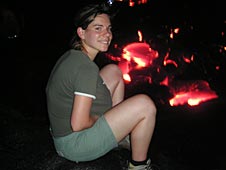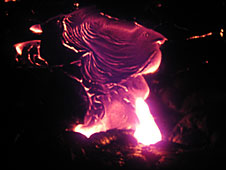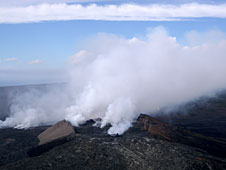Hawaii Volcanoes National Park
Well-known for its volcanic significance, Hawaii Volcanoes National Park is also one of the most fascinating biologic landscapes in the world and worthwhile a visit during your stay with us at Aloha Vacation Cottages. It’s about a 2-hr drive to Volcanoes National Park taking Hwy 19 via Hilo. We always recommend to check on lava flow update either on-line or at the phone number we provide at your Hawaii vacation cottage.
See a few of the photos our honeymoon guests from Germany took on their visit toHawaii Volcanoes National Park. Breathtaking, spectacular und unforgettable!






We recommend to get an early start and plan a day trip. Just to name a few attractive sights on your way to or back from Volcanoes National Park:
– Waipio Valley Lookout on the Hamakua Coast – see virtual tour of Hawaii
– Famous Akaka Waterfalls
– Hawaii Tropical Botanical Garden Hilo, one of the most beautiful places in Hawaii. A unique tropical nature preserve.
– Hilo Zoo.com Friends of the Zoo. Welcome to the Pana’ewa Rainforest Zoo.
On your way to or back from Volcano, don’t miss the biggest Farmer’s market of the Big Island Hilo Farmer’s market with the freshest tropical fruits, tropical flowers and vegetables at very affordable prices plus Hawaiian gifts and crafts. Days: Wednesday and Saturday (big time!). A few stands are always open during the rest of the week.

Volcanoes National Park
Hawaii Volcanoes National Park was established in 1916 as the country’s 13th National Park. It was created to preserve theregion’s unique volcanic features, its early human history, and the plant and animal life that is part of this special bio-region.
The National Park service is responsible for the protection of this great resource and its visitors.
According to Hawaiian legends, this is the home of Pele, the Hawaiian goddess of fire. Her first home was one of the smaller Hawaiian islands, Ni’ihau, but the goddess of the sea chased her from island to island, destroying each dwelling that Pele had created. Pele finally found a haven in Halema’uma’u, in Kilauea Caldera, where she resides today.
Park Entrance
Hawaii Volcanoes National Park is located 30 miles southwest of Hilo and 96 miles southeast of Kona on the Big Island of Hawaii. There is only one entrance off route 11, south of Hilo and east of Kona.
General Information
The park is open 24 hours a day, year-round, including holidays. For general information, please, call 808-985-6000 or stop at the Kilauea Visitor Center, the Thomas A. Jaggar Museum. Park information is also available at the website www.nps.gov/havo For an eruption update, call 808-985-6000. Temporary road signs will direct you to safe points whenever eruptions occur. When you enter the park, tune to AM radio 530 for park information.
Entrance Fees
Your entrance permit is good for seven consecutive days. The entrance fee is $10 per vehicle and $5 per hiker, bicyclist or motorcyclist over 16 and under 62. Entrance fee is free if you have an annual Hawai`i Tri-park Annual Pass($25), which may be obtained at park entrance stations, or an annual National Park Pass for all national parks and recreation areas.
Kilauea Visitor Center
Is located a quarter mile from the park entrance. It is open from 7:45am to 5p.m. daily. A 25-minute park movie is shown hourly and there are displays on volcano formation and geologic processes, native plants and animals, and early Hawaiians. Maps, posters, books and videotapes are for sale. Parking and restrooms are available. Backcountry permits (necessary for all overnight backcountry camping trips, no fee applies) may also be obtained.
What to bring
While touring the park, it is a good idea to wear a hat, sunglasses and sunscreen because the sun can be intense. However, the weather can change within minutes. Be prepared for cold, rainy and windy weather (4,000ft elevation) when you visit the park. Temperatures and rain vary a lot by elevation and location. While very warm at sea level, you might find freezing temperatures when climbing Mauna Loa summit. Evenings at the park can be chilly. Have warm clothes available. Wear comfortable walking shoes rather than sandals. Bring drinking water and food as they are not readily available in some areas of the park. You can get these items at the Volcano House or Volcano Village.
Safety tips
Sea cliffs and coastal lava flows can be treacherous. Stay on trails all the time. Recent lava flows are shell-like and can collapse easily. Wave action continually erodes the base of sea cliffs, undermining them and causing large parts to fall off. Fumes from volcanoes can compound respiratory or heart problems and are considered hazardous to infants, pregnant women and elderly people. Follow instructions on warning signs and handouts.
Gas stations
There are no service stations located in the park. Gas and limited automotive service is available at two stores in Volcano Village on the way to Hilo one mile northeast of the park.
History Active Volcanoes
The Hawaiian islands are mere tops of gigantic mountains rising from the floor of the ocean. The newest of these islands, Hawaii, is relatively young, geologically speaking. Five volcanoes formed the Big Island, but only three are considered active: Mauna Loa, Kilauea and Hualalai. Mauna Loa and Kilauea are two of the world’s most active volcanoes. Because the eruptions of Hawaiian volcanoes are gentler than those of most other volcanoes around the world, the edges of active vents are frequently accessible.
Mauna Loa, the second tallest mountain in the world, rises 13,677ft above sea level and descends more than 8 miles below it. Only Mauna Kea at 13,796ft surpasses it in height when measured from sea level. Mauna Loa has erupted 37 times since 1832. Its last eruption occurred in 1984, and for a time it seemed to threaten the city of Hilo.
Kilauea 4,000ft, Mauna Loa’s smaller neighbor, is one of the world’s most active volcanoes. For more than 100 years, Kilauea was almost continuously active. The current eruption began January 3, 1983, and is the largest and longest flank eruption in history. There is no indication when it may end. Go to www.hvo.wr.usgs.gov/ for current volcano information and photographs.
Rain Forest
The windward side of Kilauea, with an annual rainfall of more than 100 inches, has a distinctive rain forest.
Flora and Fauna
Hawaii’s tropical climate and isolation have developed a diversity of native species. Some animals and plants are endemic (found only in Hawaii). Sadly, many native species are extinct, destroyed by non-native plants and animals and by humans. The NPS is involved in efforts to ensure the future of other endangered species in the park, like the Nene goose, the state bird of Hawaii.
More information about the Big Island Volcanoes.
Explore Ancient Lava Tubes – Unique experience on the Big Island of Hawaii.
Hawaii Volcanoes National Park
Volcano Winery – Experience exotic Hawaiian wines made nowhere else on earth, next to Hawaii Volcanoes National Park.
Watch Hawaii’s active volcano from the air.
Check with Big Island helicopter companies for prices on Hawaii Volcanoes National Park Tours
Volcanoes National Park as seen from the helicopter. Our guest Karsten took those impressive photos at his helicopter trip over the park. He also took some great photos while visiting Mauna Kea observatories.



Blue Hawaiian Helicopters Circle of Fire Plus Waterfalls (45 minutes)Safari Helicopters Deluxe Volcano / Coast Safari (50-55 minutes)
Sunshine Helicopters Formations of Pele-Kilauea Volcano (45 – 50 minutes)
Tropical Helicopters Feel the Heat with Waterfalls – The Ultimate Experience (45 minutes)

